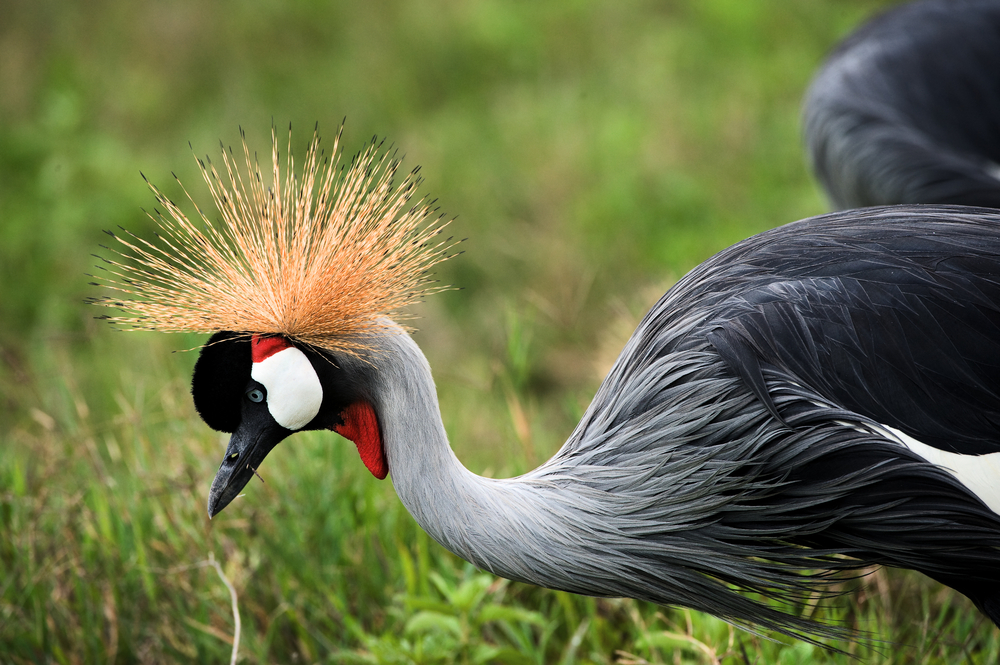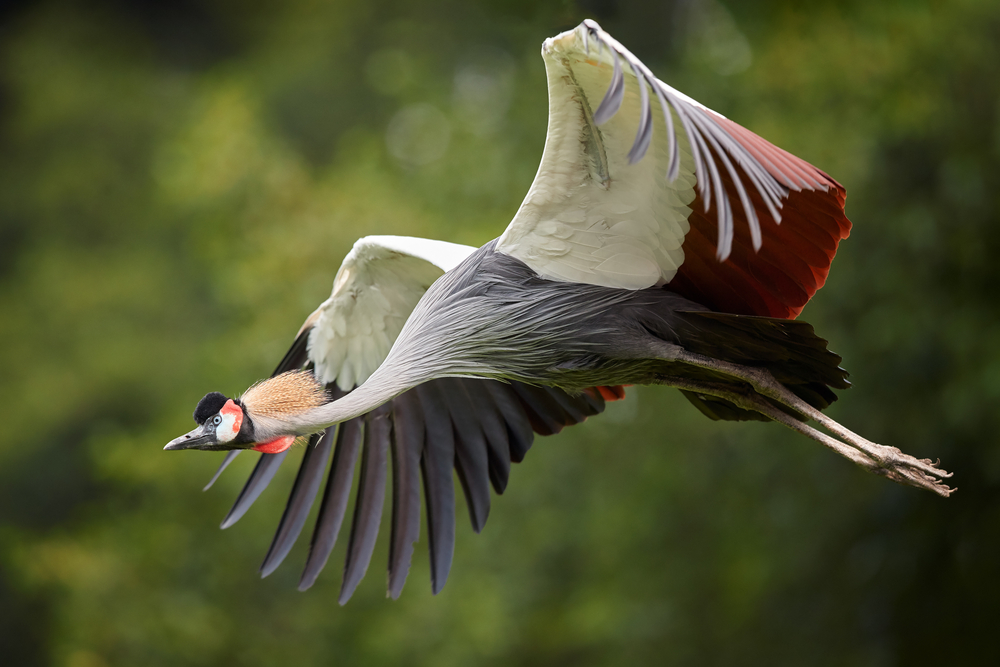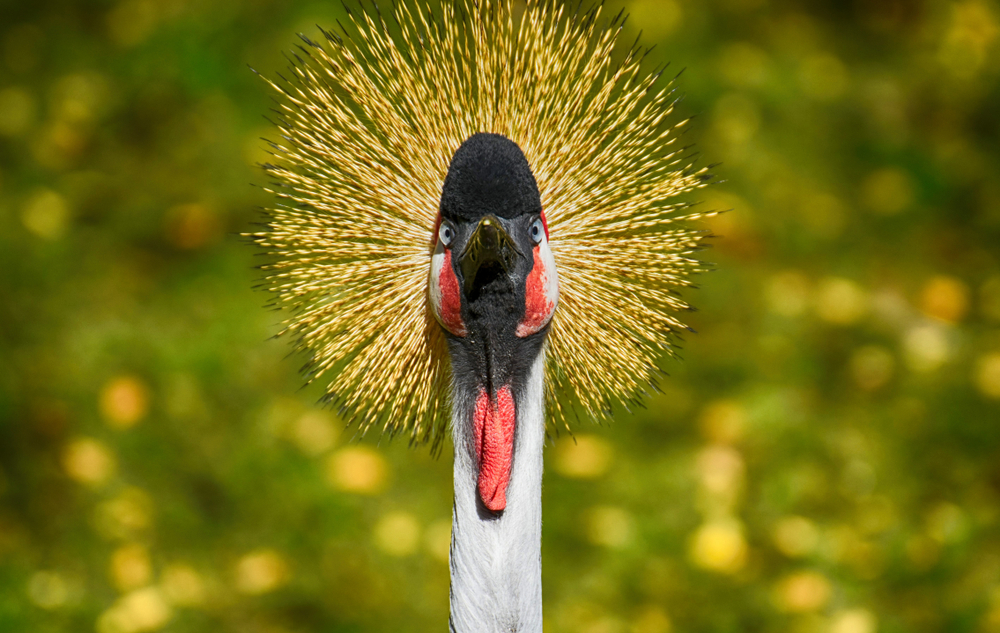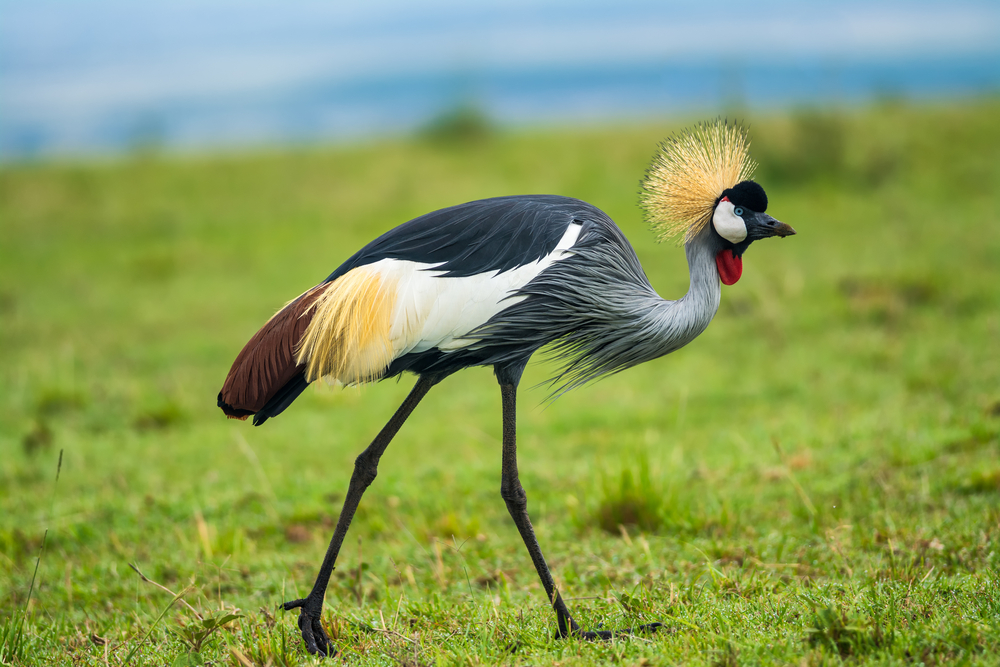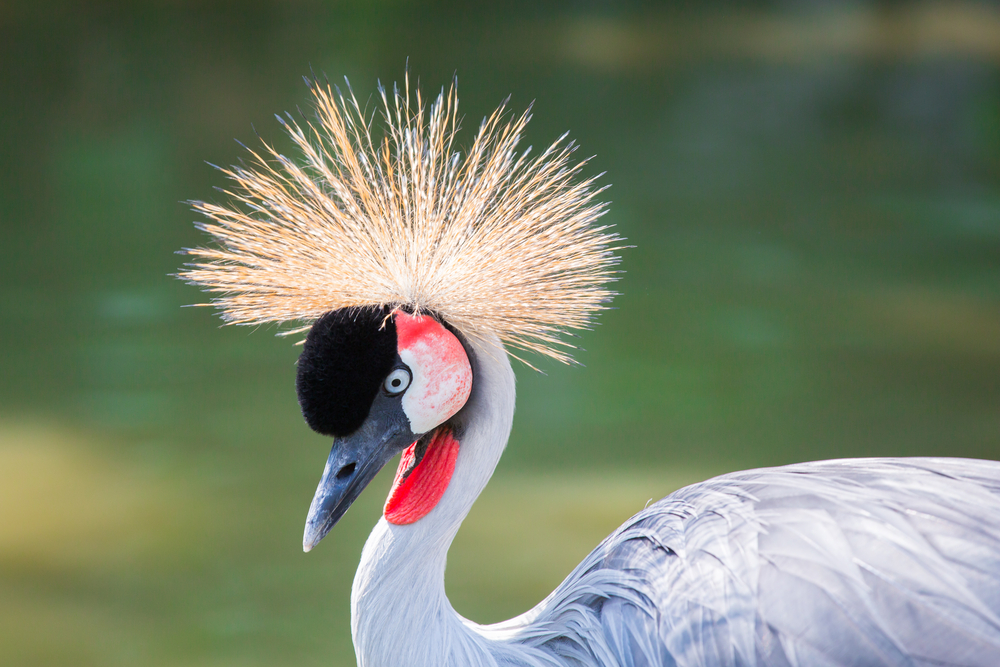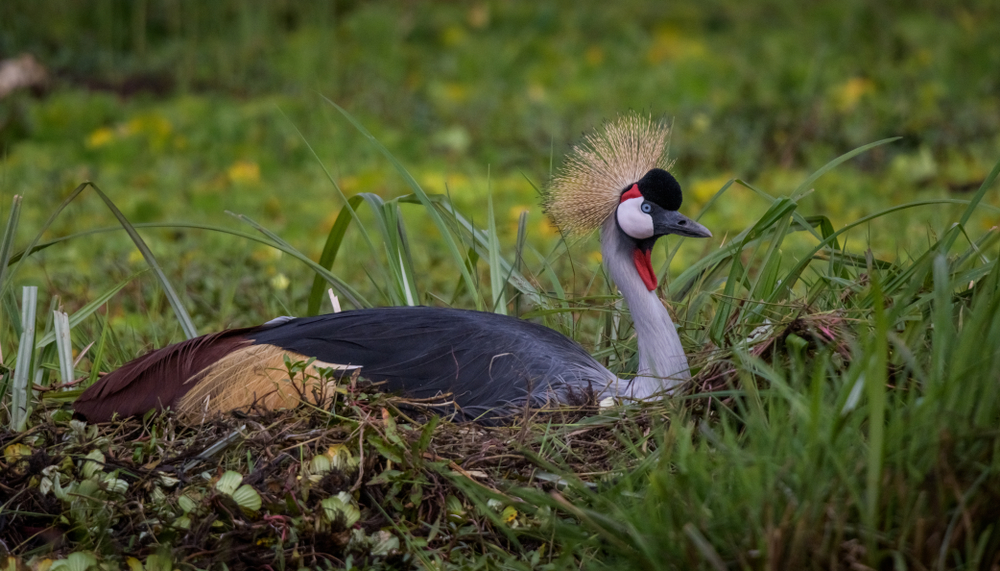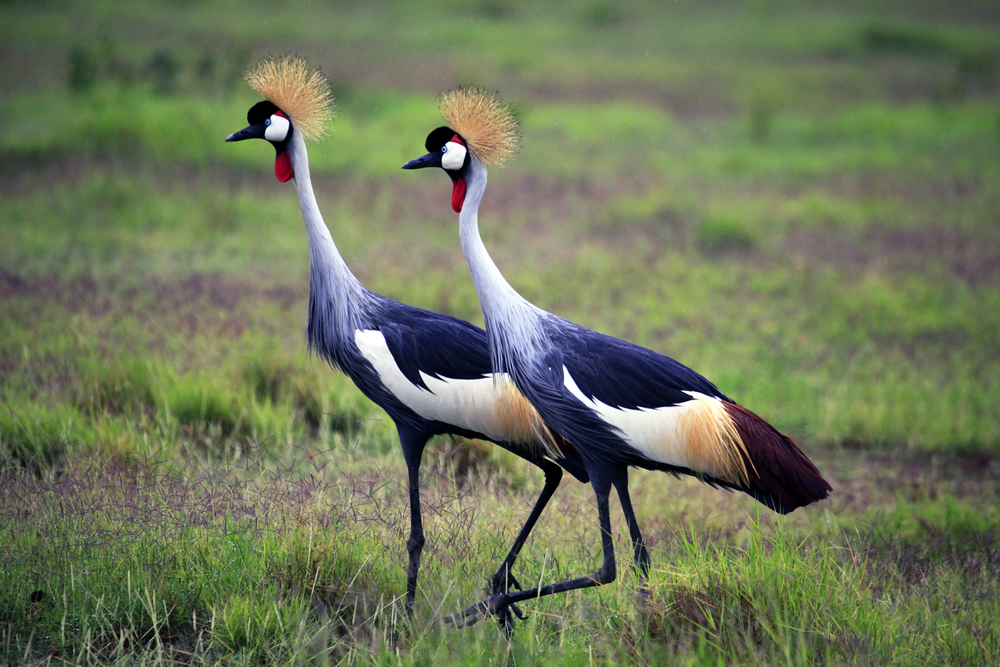About
The Grey Crowned Crane, scientifically known as Balearica regulorum, is a majestic bird species found in the Animal Kingdom’s phylum Chordata and class Aves. It belongs to the Gruidae family, which also includes other crane species such as the Sandhill Crane and the Whooping Crane. Native to the wetlands and grasslands of eastern and southern Africa, the Grey Crowned Crane is known for its elegant appearance and distinctive crown of golden feathers.
These cranes are characterized by their tall stature, long necks, and striking plumage. They have predominantly gray bodies, with white wings and a black-and-white head adorned with a crown of stiff golden feathers. Grey Crowned Cranes have long legs and a wingspan of up to 2 meters, allowing them to soar gracefully through the air and perform elaborate courtship displays during the breeding season.
Grey Crowned Cranes are omnivorous, feeding on a varied diet that includes insects, small vertebrates, seeds, grains, and aquatic vegetation. They are often found in marshes, wetlands, and grasslands where they forage for food and construct their nests. These cranes are highly social birds, often forming large flocks during the non-breeding season and engaging in complex social behaviors such as dancing and vocalizations.
Conservation Concerns
The conservation status of the Grey Crowned Crane is a cause for concern, and it is listed as vulnerable on the International Union for Conservation of Nature (IUCN) Red List. These cranes face threats from habitat loss and degradation due to human activities such as agriculture, urbanization, and drainage of wetlands.
Other factors contributing to their decline include illegal trade for the pet market, disturbance by humans, and collisions with power lines and vehicles. Conservation efforts aimed at protecting critical wetland habitats, regulating trade, and raising awareness about the importance of crane conservation are essential for ensuring the long-term survival of the Grey Crowned Crane and other wetland-dependent species. Continued monitoring and research are necessary to assess population trends and implement effective conservation strategies.
Physical Characteristics
The Grey Crowned Crane (Balearica regulorum) is a strikingly beautiful bird, renowned for its distinctive crest of golden feathers. Native to the wetlands and grasslands of Africa, south of the Sahara, this bird is not only admired for its elegant appearance but also holds cultural significance in several African countries, symbolizing wealth and longevity.
Size and Weight:
- Height: Grey Crowned Cranes stand about 3 to 4 feet tall (0.9 to 1.2 meters), making them one of the taller crane species.
- Weight: They typically weigh between 6.6 to 8.8 pounds (3 to 4 kilograms), with slight variations between males and females.
Physical Characteristics:
- Crest: The most iconic feature of the Grey Crowned Crane is its crest of stiff golden feathers that fan out on top of its head. This crest is complemented by a striking black and white face pattern, with white cheeks and a red gular sack under the chin, which inflates during vocalization.
- Plumage: The body plumage is primarily grey, with a white wing patch that becomes visible during flight. The long, elegant neck is pale grey, transitioning into a darker grey towards the body. The tail feathers are also predominantly grey.
- Beak and Eyes: The crane’s sharp, pointed beak is relatively short and light grey in color, well-suited for its omnivorous diet. Its eyes are surrounded by bare white skin, contrasting with the dark pupils and adding to the bird’s expressive appearance.
- Legs and Feet: They have long, slender black legs and feet, adapted for wading through wetlands. The crane’s long legs are not only useful for navigating shallow waters but also play a crucial role in their elaborate mating dances.
- Vocalization: Grey Crowned Cranes have a distinctive, deep, booming call that can be heard over long distances. This call is important for communication between individuals, especially during mating rituals.
- Behavior and Diet: These cranes are both terrestrial and arboreal, often seen roosting in trees, which is unusual among cranes. They feed on a varied diet that includes plants, seeds, grains, insects, and small animals.
The Grey Crowned Crane is not only a symbol of beauty in the natural world but also an important indicator of healthy wetland ecosystems. Despite their elegance and cultural importance, Grey Crowned Cranes face threats from habitat destruction and illegal trade, highlighting the need for continued conservation efforts to ensure their survival and the health of their habitats.
Reproduction
The reproductive cycle of the Grey Crowned Crane is a fascinating process shaped by seasonal and environmental factors. Here’s an overview:
Breeding Season: Grey Crowned Cranes typically breed during the wet season when food availability is abundant and nesting conditions are favorable. The breeding season varies depending on the region but often coincides with the onset of rains.
Courtship Displays: During the breeding season, Grey Crowned Crane pairs engage in elaborate courtship displays to strengthen their bond and establish breeding territories. These displays include dancing, bowing, and vocalizations, showcasing the birds’ vibrant plumage and intricate head ornaments.
Nesting Behavior: Once pairs have formed, they build large, elaborate nests in marshy areas or wetlands, usually constructed from reeds, grasses, and other plant materials. The female lays her eggs in the nest, typically laying 2 eggs, although clutch sizes may vary.
Incubation Period: Both the male and female Grey Crowned Crane take turns incubating the eggs, which lasts for about 28 to 31 days. During incubation, the parents carefully tend to the eggs, rotating them regularly to ensure even warming and protection from predators.
Hatching and Chick Rearing: After the incubation period, the eggs hatch, and the chicks emerge. Grey Crowned Crane chicks are precocial, meaning they are relatively mature and mobile shortly after hatching. They are covered in downy feathers and are able to leave the nest and forage with their parents shortly after hatching.
Parental Care: Both parents play active roles in caring for the chicks, providing them with food and protection from predators. The chicks stay close to their parents, learning essential skills such as foraging and predator avoidance.
Fledging and Independence: Grey Crowned Crane chicks grow rapidly and are capable of flight within a few weeks of hatching. Once they are fully fledged, they gradually become more independent from their parents, although family groups may remain together for some time.
Population Dynamics: The reproductive success of Grey Crowned Cranes is crucial for maintaining healthy populations of these iconic birds. However, they face various threats, including habitat loss, poaching, and pesticide poisoning, which can impact their breeding success and overall population numbers.
Conservation Efforts: Efforts to conserve Grey Crowned Cranes focus on protecting their wetland habitats, reducing human disturbances, and raising awareness about the importance of crane conservation. By safeguarding their breeding habitats and addressing key threats, conservationists aim to ensure the continued survival of these majestic birds for future generations.
Lifespan
The grey crowned crane (Balearica regulorum) is a striking bird species native to Eastern and Southern Africa, known for its distinctive appearance characterized by a crown of golden feathers atop its head. These elegant birds inhabit grasslands, wetlands, and savannas, where they forage for food and perform elaborate courtship displays. Here’s an overview of the grey crowned crane’s lifespan and threats to its life:
Lifespan in the Wild: In their natural habitat, grey crowned cranes have an average lifespan of approximately 20 to 25 years. However, factors such as predation, habitat loss, and human activities can affect individual lifespans within wild populations.
Lifespan in Captivity: Grey crowned cranes kept in captivity, such as in zoos and wildlife rehabilitation centers, may have a slightly longer lifespan compared to those in the wild. With access to consistent food, veterinary care, and protection from predators, captive individuals can potentially live beyond their typical lifespan in the wild.
Threats to Grey Crowned Cranes:
- Habitat Loss and Degradation: One of the most significant threats to grey crowned cranes is the loss and degradation of their natural habitat due to human activities such as agriculture, urbanization, and infrastructure development. Wetland drainage, conversion of grasslands to farmland, and deforestation reduce available nesting sites and foraging grounds for these birds.
- Illegal Wildlife Trade: Grey crowned cranes are often targeted by illegal wildlife traffickers for the exotic pet trade and traditional medicine markets. The capture and trade of wild-caught individuals for their distinctive plumage and perceived cultural value pose a significant threat to wild populations.
- Human-Wildlife Conflict: Encroachment of human settlements into crane habitat can lead to conflicts between humans and birds, especially if cranes damage crops or compete for resources. Retaliatory killings and habitat disturbance further exacerbate population declines.
- Pollution and Contamination: Pollution of waterways and wetlands with agricultural runoff, industrial waste, and chemical pollutants can negatively impact the health of grey-crowned cranes and their prey species. Contaminated water sources can lead to poisoning and disease outbreaks among crane populations.
- Climate Change: Climate variability and change can alter rainfall patterns, disrupt wetland ecosystems, and affect the availability of suitable habitat and food resources for grey-crowned cranes. Extreme weather events such as droughts and floods can further stress populations already facing habitat loss and degradation.
Conservation efforts aimed at protecting grey-crowned cranes include habitat restoration and preservation initiatives, the establishment of protected areas, community-based conservation programs, anti-poaching measures, and raising awareness about the importance of crane conservation among local communities and stakeholders. By addressing these threats and implementing sustainable management practices, it is possible to safeguard the future of grey-crowned crane populations in their native range.
Eating Habits
The grey crowned crane (Balearica regulorum) is a striking bird known for its distinctive appearance and graceful demeanor. Understanding its eating habits sheds light on its dietary preferences and foraging behavior. Let’s delve into the feeding habits of the grey crowned crane.
Diet: The grey crowned crane is primarily omnivorous, with a varied diet that includes:
- Plant Matter: A significant portion of the grey crowned crane’s diet consists of plant material such as seeds, grains, grasses, and vegetation. It forages for these plant foods both on the ground and in shallow water bodies.
- Invertebrates: In addition to plant matter, the grey crowned crane also feeds on various invertebrates, including insects, insect larvae, snails, and small crustaceans. These protein-rich prey items supplement its diet with essential nutrients.
- Small Vertebrates: On occasion, grey crowned cranes may opportunistically feed on small vertebrates such as frogs, lizards, small rodents, and even small birds. However, these animal prey items constitute a smaller proportion of their overall diet compared to plant matter and invertebrates.
Foraging Behavior: Grey crowned cranes employ several foraging techniques to obtain food:
- Ground Foraging: They spend a significant amount of time foraging on the ground, probing and pecking at the soil to unearth seeds, grains, and insects hidden among the vegetation. Their long legs and slender bills are well-adapted for this type of ground-based feeding.
- Wading and Picking: Grey crowned cranes also wade in shallow water bodies such as wetlands, marshes, and ponds, where they use their bills to pick aquatic vegetation and aquatic invertebrates from the water’s surface or substrate.
- Stalking and Pouncing: When hunting for small vertebrates, grey crowned cranes may exhibit stalking behavior, cautiously approaching their prey before swiftly pouncing to capture it with their sharp beaks.
Dietary Adaptations:
- The grey crowned crane’s slender bill is well-suited for picking and probing in soil and shallow water, allowing it to extract food items with precision.
- Their omnivorous diet provides flexibility in food choices, allowing them to adapt to seasonal changes in food availability and habitat conditions.
Role in Ecosystem:
- As omnivorous birds, grey-crowned cranes contribute to ecosystem health by regulating insect populations and dispersing seeds, thereby influencing plant distribution and diversity in their habitats.
Conservation Concerns:
- Habitat loss, degradation, and fragmentation are significant threats to grey-crowned cranes, affecting both their foraging habitats and the availability of suitable food resources.
- Conservation efforts focused on preserving wetland habitats, implementing sustainable land management practices, and reducing human-wildlife conflicts are crucial for safeguarding the grey-crowned crane’s food sources and overall survival.
Uniqueness
The Grey Crowned Crane, scientifically known as Balearica regulorum, is a strikingly beautiful bird known for its unique features and behaviors. Native to the savannas of eastern and southern Africa, this crane stands out for several reasons that make it a symbol of grace and beauty in the animal kingdom. Here are some key aspects that make the Grey Crowned Crane unique:
Distinctive Appearance: The Grey Crowned Crane is famous for its eye-catching plumage. It sports a body of mainly grey feathers, with wings that are predominantly white, but with feathers that flash gold when in flight. Its most distinctive feature is its crown of stiff golden feathers, which give the bird its name. The face is white, and a bright red inflatable throat pouch contrasts sharply against its light coloring.
Elaborate Courtship Dance: Grey Crowned Cranes are known for their intricate and theatrical courtship dances. These dances include an array of impressive jumps, bows, and calls. Both males and females participate in these rituals, which strengthen their bonds and are a critical part of their mating process.
Vocal Communication: This species is quite vocal, using different calls to communicate across the wide savanna. Their call is a loud and carrying “wonk” or “honk,” which is often performed in a duet between mated pairs, each bird’s call complementing the other’s in a complex and synchronized pattern.
Omnivorous Diet: Unlike many other cranes that are more specialized in their feeding habits, the Grey Crowned Crane has an omnivorous diet. It feeds on grass seeds, insects, amphibians, and other small animals, making it adaptable to different environments and seasonal changes.
Non-Migratory: Grey Crowned Cranes are largely sedentary, meaning they do not migrate long distances like many other crane species. They tend to stay within a relatively fixed range throughout the year, although they may move locally in response to changes in water availability and food.
Breeding and Nesting: These cranes nest in more varied locations than most other cranes, often choosing to nest in trees, which is unusual among cranes that typically nest on the ground. This adaptation helps protect their eggs and chicks from ground-based predators.
Endangered Status: The Grey Crowned Crane is listed as endangered by the International Union for Conservation of Nature (IUCN) due to habitat loss, degradation, and the illegal pet trade. Their distinctiveness and rarity also make them a target for capture, as they are highly prized within the illegal pet trade.
Cultural Significance: In many cultures across Africa, the Grey Crowned Crane is a symbol of wealth and longevity. It is also Uganda’s national bird, featured on the country’s flag and coat of arms, highlighting its importance and revered status in Ugandan culture.
The combination of their striking physical appearance, elaborate mating dances, adaptability in diet, and their role in cultural symbolism make the Grey Crowned Crane a unique and valuable species in Africa’s biodiversity. Conservation efforts are critical to ensure their survival and continued presence in the wild.
Related Family Species
Sources
- Alden, Peter et al, National Audubon Society Field Guide to African Wildlife, New York, NY.
- Burnie, David & Wilson, Don, Animal, Smithsonian Institute, Washington DC.
- Hickman et al, Integrated Principle of Zoology, McGraw Hill, Boston.
- Nolting, Mark, Africa’s Top Wildlife Countries, Global Travel Publishers, Inc., Ft. Laurderdale, FL.
- Paragon, The Ultimate Guide to Wildlife in North America, Atlantic Publishing, UK.



































































